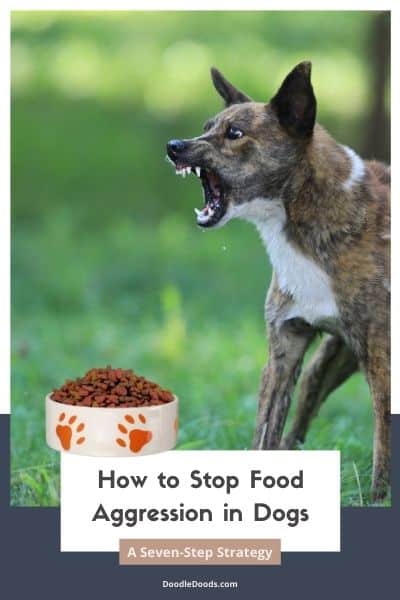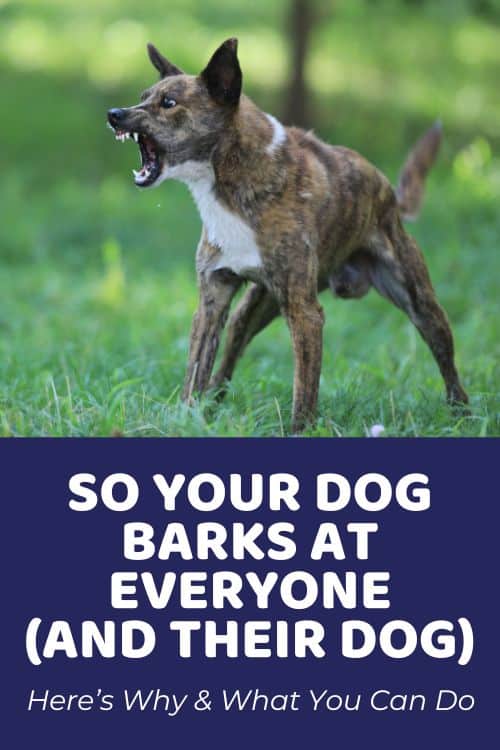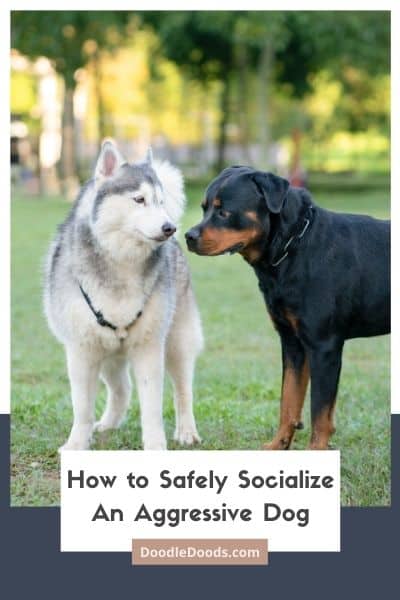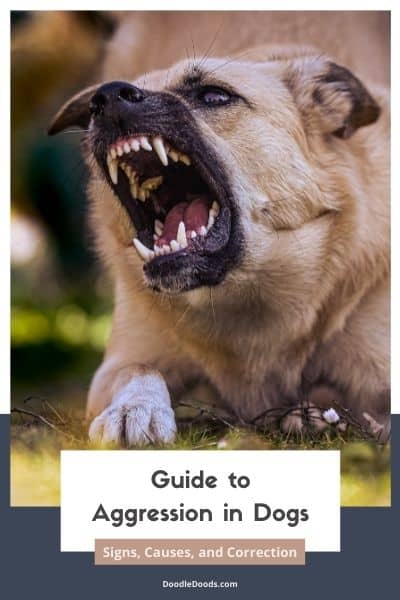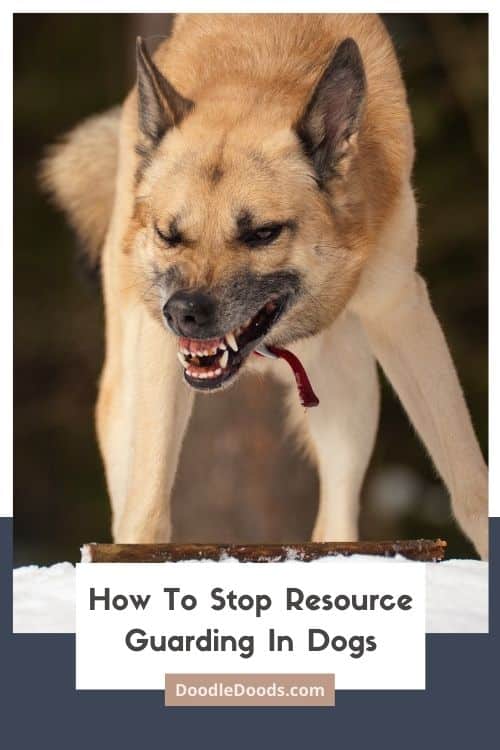Like most other animals, dogs can be territorial creatures, possessive about their home, family, toys, and especially about their food. Resource guarding is a common canine issue, albeit, with different levels of severity, that can lead to a whole host of unwanted behaviors. Many of these will make you think twice about venturing near your pup’s food bowl during mealtimes.
Giving your Dood a wide-berth while they’re eating may seem the most logical way to prevent food-related aggression. However, by doing this, you are only reinforcing the behavior. While that might not seem like a big deal, once learned, this kind of possessive guarding could extend beyond your dog simply protecting their food. Moreover, any kind of aggression, no matter how small, should never be ignored.
In this article, we’ll provide some practical and actionable ways you can deal with your Doodle’s food aggression without putting yourself in harm’s way.
Table of Contents
- Food Aggression in Dogs: A Quick Overview
- Sure Signs Your Dog is Food Aggressive
- The Different Types of Food Aggression In Dogs
- How To Fix Food Aggression In Dogs
- How To Stop Food Aggression With Other Dogs
- How To Punish Food Aggression In Dogs – Should You Even Do It?
- How to Stop Food Aggression in Dogs: Conclusion
Food Aggression in Dogs: A Quick Overview
In the wild, doggy ancestors never knew where their next meal was coming from. And often, they had to fend off other predators to keep what was theirs. The ones who developed successful ways of doing this were the ones the survived and passed their genes along. That’s why resource guarding tends to be an instinct common to all dogs, although the way this is done differs significantly from breed to breed.
Luckily for us, both domestication and selective breeding have significantly watered down these kinds of aggressive survival instincts in dogs today. This not only means that resource guarding is a far less common issue than it otherwise might have been, but when it does arise, it’s not all that difficult to shake. While your pup might still be inclined to warn dogs away from a delicious treat, the behavior is rarely directed toward people.
That being said, certain environmental cues can spark this instinct back up – especially in breeds that are more prone to aggressive or guarding actions. Factors that may lead to food aggression include early competition, where your pup had to compete with littermates for the biggest portion of shared food, and experience, where dogs have had food taken away from them. This might be used as part of a punishment for something.
Shelter dogs are at particular risk of resource guarding. Not only is this to do with them probably being fed communally and having to work for their food, but they are also more likely to have suffered the kind of trauma (abuse, neglect, losing a caretaker, fighting with other dogs) that makes them more anxious overall. Like many other kinds of unwanted behaviors (especially the aggressive seeming ones), food guarding is often rooted in fear.
Sure Signs Your Dog is Food Aggressive
Food aggression can manifest in a variety of behaviors – some less threatening and some a whole lot more. These usually link with your pooch’s overall temperament (partly to do with their breed and partly just to do with them) and the lessons they have learned about how resources come to them and how they might lose them.
Early training and socialization also play a big part in this. If your dog trusts you, they are more likely to be comfortable about you being around their food. If they are wary of strangers through not being around other people enough from a young age, they will be more fearful and more inclined to act out.
Food aggression is generally pretty simple to spot. While eating, your pup will keep their head over the bowl, hovering over it to protect it. They might also stiffen their body, keep their tail low with their hackles raised and their ears pressed backward. As the person or other dog gets closer, they may start to show their teeth, growl, snap, or even bite.
The Different Types of Food Aggression In Dogs
As hostile actions can range quite widely from seemingly benign behavior, such as running away with favored treats and toys, right up to full-blown aggressive acts like lunging and chasing people away, experts have come up with a way to categorize food aggression in dogs. This helps with determining the best approach to fixing it.
- With mild food aggression, they show their teeth and growl. They may also bare their teeth and raise their hackles in warning.
- With moderate food aggression, they snap or lunge when a person or other dog approaches them but will stay near the bowl.
- With severe food aggression, they actually bite or will actively chase the person or other dog away.
Food aggression may also differ in terms of what it’s linked to. If your pet is less worried about food (knowing that it comes regularly), they might only display aggression with a special treat – a chew, for instance. As these tend to be tastier than your average kibble and come about less often, they are usually considered of higher value to your dog.
Beyond that, dogs may respond differently to dogs, people they know, and people they don’t. This is based on who or what they perceive to be a threat. It’s far more likely for dogs to extend food aggression to other dogs. After all, the chances are pretty high that the other dog may attempt to take some away. You might not be as worried about this.
Finally, there could be variations in your pup’s underlying motivation. While dominance theories that once (pardon the pun) dominated dog training are mostly considered outdated today, there may still be lessons to be learned in terms of how dogs interact with one another. While most food guarding derives from fear of losing resources, some dogs might use it to assert dominance – this is especially common in multi-dog homes.
How To Fix Food Aggression In Dogs
As we’ve touched on above, dealing with food guarding doesn’t need to be that big a deal. Most dogs, as they develop in confidence and learn that food is not such a scarce resource, will relax into things. The following steps can just help speed up the process.
It is crucial, though, that you are able to accurately gauge the situation as it relates specifically to your dog. If you believe or come to believe in training that your pet might actually bite you, then it’s time to call in the experts to help you with this one. Never put yourself in a potentially dangerous situation, and never ignore your dog’s warnings.
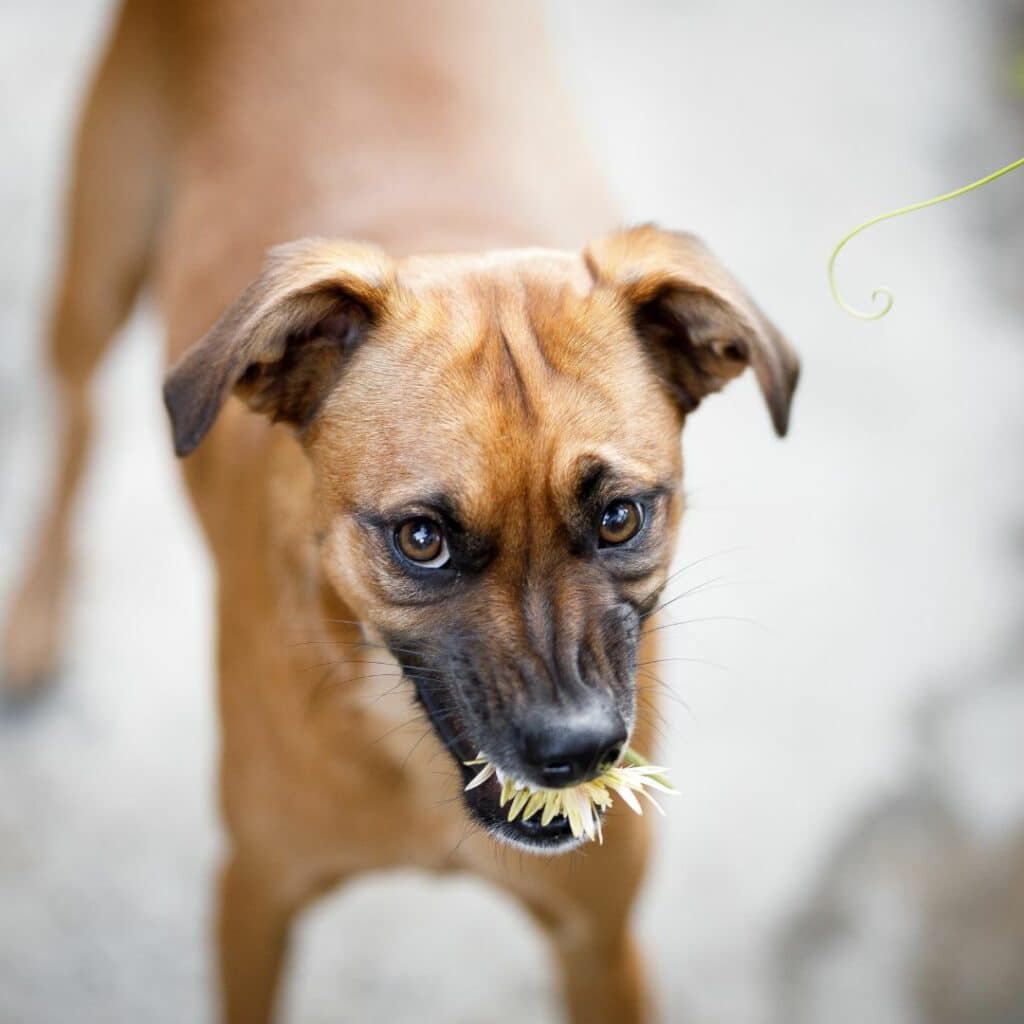
How To Stop Food Aggression In A Puppy
With your new puppy, it’s a good idea to sit with them and hand-feed them their kibble on a regular basis. As you do, speak to them, praise them, stroke them, and just generally get them comfortable with your presence and with being handled while they eat.
For the next step, place their bowl on your lap and encourage them to eat their food from there. Finally, put the bowl on the floor but stay near. Every now and again, drop something tasty in. Doing this should help your dog not to feel threatened by people being around while they eat, especially when coupled with thorough early socialization.
How To Stop Food Aggression In Dogs: Older Dogs and Rescues
Modifying the behavior of older dogs, as you might imagine, requires more time and patience than training a puppy or younger dog. However, it can be done via a careful process of desensitization and counter-conditioning. You’ll focus first on getting your pooch accustomed to the presence of people at mealtimes. Then, once they are comfortable, you’ll encourage them not to react when having their bowl removed for brief periods, even while they are eating.
Before you start retraining your pup, you’ll want to ensure that you develop a consistent feeding routine. Giving your pet their meals at the same time each day will reassure them that this resource is not limited and that they will never go hungry. Dogs have a pretty good internal clock and feel soothed by knowing what to expect from their environment.
It’s also a good idea to exercise your dog before feeding them. Not only does this fulfill their intrinsic desire to hunt their food, but it also burns off the excess energy that might make them more reactive to people approaching their bowl during mealtimes.
When progressing between each of the different steps, the overarching aim should be to make this as positive an experience as possible for your pup. In this way, you’ll want to keep them well below the threshold of reactivity. Take your time with each step, don’t move on to the next after a single calm encounter. Instead, repeat each one until you’re sure your pal is comfortable. A good rule of thumb is ten non-reactive attempts.
Step One
This is about simply getting your dog used to your presence in the room during their mealtimes. Give them plenty of space to make it clear you are not there for their food. If you see them reacting, then move back a little more. Speak to them in even soothing tones, then, once they are finished with their meal, get them to come to you and give them a treat. Here you are rewarding your pup for remaining calm.
Step Two
When this basic level of trust has been established, you can start to move closer to your dog while they are eating. You might need to do this in stages, making a little more progress each day. Again reward them at the end for staying calm. Once you are able to get right up to the bowl without your dog worrying, pop a nice little treat in their bowl and then leave. Just be sure never to do this if they react in any way.
Step Three
Here you will be venturing right up to the bowl and back multiple times. As you come and go, leave a treat when your dog is calm, and move away. By doing this, you are demonstrating that it’s the calmness that gets them the reward – this is the behavior you’re reinforcing. If your dog is eating too quickly for you to manage this, look into getting them a slow-feed bowl. This will be better for their overall health anyway.
Step Four
This looks a lot like step three, but rather than you placing the treat into the bowl for your dog, you should be handing it to them. This firms up the idea in their mind that having people around while they are eating is actually a positive thing rather than a negative one. Each day move the hand offering the treat a little closer to the bowl. In doing this, you are edging towards being able to touch the bowl.
Step Five
As your dog becomes increasingly confident that you are not interested in removing their food, you should be able to easily reach out and touch their bowl without them reacting. At first, do this when your pal is busy with the treat, but then gradually start to do it a little in advance until you are able to first touch the bowl and then give your dog the treat. They will come to realize that allowing you to do this is what gets them the treat in the first place. At this stage, be careful not to move the bowl or take anything from it.
Step Six
This one is quite a large leap, so don’t be too surprised if it gets a response from your pet despite them remaining calm through the rest of the steps. What you want to be doing here is lifting the bowl a little off the ground (think an inch or two at first) and quickly popping the treat inside. Use a calm voice to speak to your dog as you do. Eventually, you should be able to lift it all the way to the counter, put it down and then fetch the treat.
Step Seven
Finally, you will be able to pick up your dog’s bowl and put it on the counter while you cross the room to fetch a treat from the cupboard before popping it back down again. This is the stage when you can start to bring other people into the training – family members and friends. Get them to move through the above steps. They should be able to make pretty quick progress until all signs of your dog’s food aggression are gone.
How To Stop Food Aggression With Other Dogs
Dog food aggression is a common issue in families where there’s more than one pooch to dote on. Although it’s more common in dogs who have been strays, experienced trauma, or come from shelters where they felt like they had to fight for their food with other dogs, it can actually happen with any dog when the resource guarding instinct kicks in.
So, how to deal with food aggression in dogs when other dogs are involved? An easy trick is to feed your dogs at the same time, but in different rooms. This way, they don’t have to “fight” or be assertive for their food and won’t see their “competition” whilst trying to eat their meal.
We also recommend you stick to the same mealtimes every day so that neither of your pups will feel the fear or anxiety surrounding their next meal. You should feed your dogs in the same spots as well and also assign each of them their own food bowl that only they will use for their meals. You want to alleviate as much anxiety as possible so that your dogs know when they can have their tasty kibble.
Of course, make sure that you’re feeding your dog the right amount of food according to their size, age, and breed. If one or both of your dogs stays hungry, they may start to become aggressive around their food and their canine family members.
Above all, try to make the experience as positive and enjoyable for your dogs as possible. Encourage good eating habits with praise, healthy treats, and overall keeping a positive attitude. Positive reinforcement is key both when training basic manners or when dealing with those undesired behaviors and behavioral issues.
In severe cases, you might want to consider reaching out to a professional dog trainer or a dog behaviorist to tackle the issue. You can also get help from Baxter & Bella’s Online Puppy School that not only covers basic training and desensitization techniques, but also has countless resources on common behavioral issues, such as how to stop food aggression in dogs.
How To Punish Food Aggression In Dogs – Should You Even Do It?
You might be wondering how to punish food aggression in dogs if the situation arises? The answer is a firm no – you should never EVER punish your pup’s food aggression. Raising your voice, lashing out, or taking the food away completely could make them increasingly fearful. This could make them react more strongly than they otherwise might have intended. Otherwise, it could worsen the situation. You have confirmed your dog’s fears that you are a threat to the things they value. It could even go so far as to damage your entire relationship with your dog.
That being said, you don’t want to simply take their behavior lying down, either. If your hound learns that their threatening actions make you back down, it will become even more reinforced in their minds. They are getting what they want. However, never attempt to take your pet’s food bowl or treat away if they are showing their teeth. It might seem like the logical thing to deprive them of their ‘reward,’ but you never know how far a dog will go to guard their resources.
The trick is to remain calm, assertive, and consistent in all your interactions with your dog. Let them know that they don’t need to fear you but always project that you don’t fear them, either. Move purposefully toward and away from the bowl as though it were always your intention to do what you were doing. If your pooch does react badly at any stage, don’t push the situation. Instead, withdraw any offered treat and your attention so as to not reinforce the unwanted behavior.
When your dog displays signs of food aggression, it may seem like the simplest solution to alter the environment to reduce the issue. After all, it really doesn’t take much effort on your part to vacate the kitchen when your dog is eating and give them space. However, this solution may be made more complicated by the presence of children who don’t pick up canine cues in the same way and so could get hurt. Beyond that, the behavior could escalate if left unchecked into guarding other resources and become far harder to ignore.
Desensitization and counterconditioning are about reducing fear and teaching your pup new ways to interact with you. In doing this, the first thing to be aware of is how they are feeling. Cues in their body language, such as their posture and tail position, can help you gauge whether they are relaxed or agitated. You never want to put your pet in a situation that makes them more anxious.
How to Stop Food Aggression in Dogs: Conclusion
Depending on your dog’s age and temperament, it can take time to correct this issue. Patience is going to be your friend while you’re doing so. Every step you take towards desensitizing your dog to people being present when they are eating and teaching them to remain calm when they are approached needs to be taken slowly, calmly, and confidently. In this way, you can help your four-legged friend understand that they will always have enough food and don’t need to guard what they have been given.
Learn How to Care for Your Doodle Puppy!
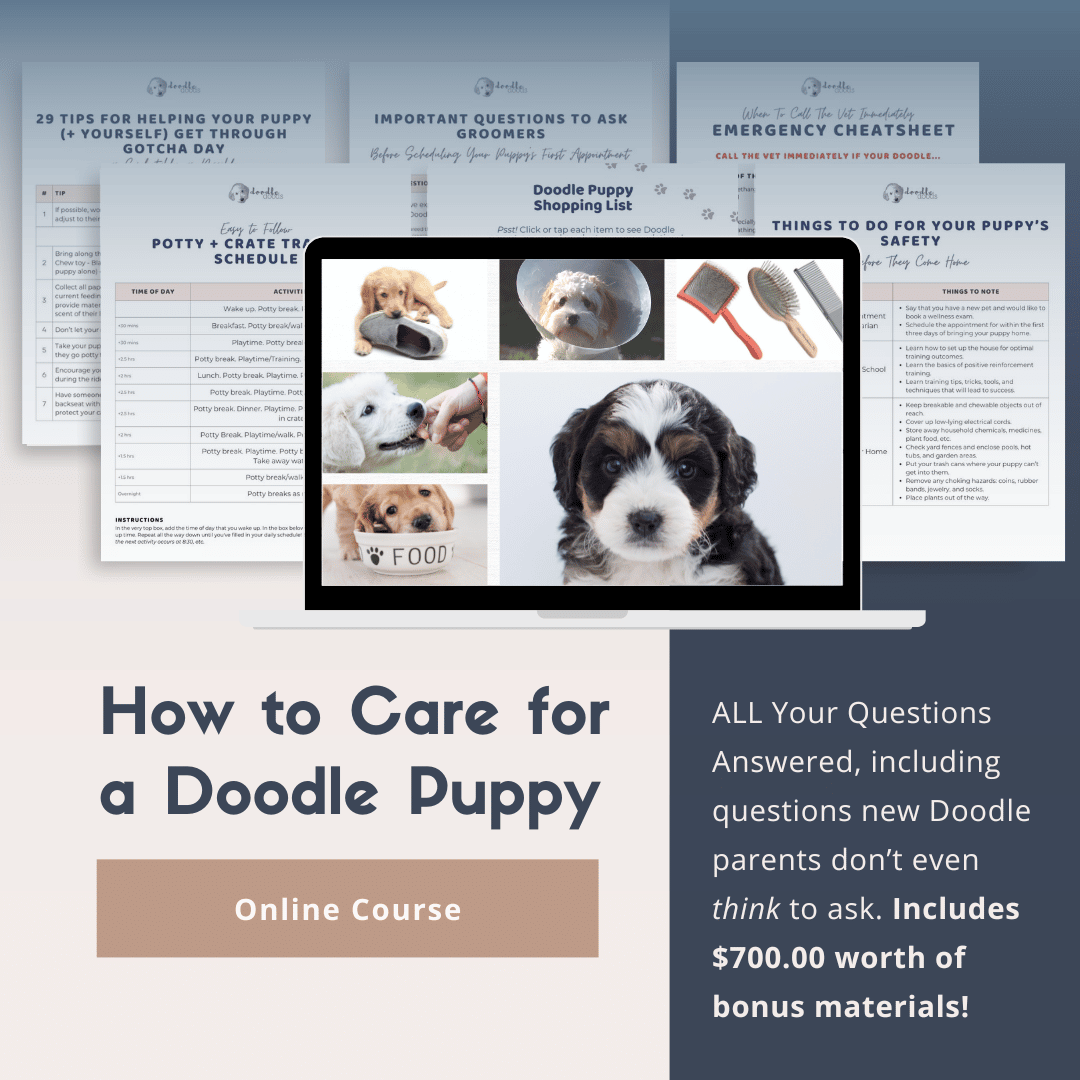
Perfect for first-time Doodle parents, get ALL your questions answered, including questions new Doodle parents don’t even think to ask.
Plus, get $700 worth of Bonus Materials for FREE, including:- Doodle Parenthood Community and Support Group ($190 value)
- Doodle Puppy Growth Tracker ($20 value)
- EMERGENCY Cheatsheet: When To Call The Vet Immediately ($50 value)
- HELP! Button ($145 value)
- And SO MUCH MORE!

